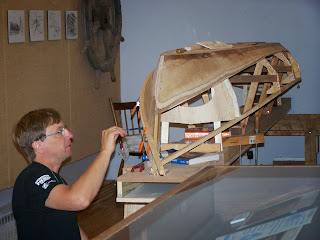This is a follow up to a story that began in 2012, the story
of a man and the boat that was built at the Colchester Historeum. It should be
noted that I joined the Historeum in April 2013 so there are some gaps that I
will try to fill in.
In the summer of 2012 Colchester Historical Society member
David Boehm decided to undertake the task of building a canoe, a model known as
a Fiddlehead 14’. Our current exhibit at the time was “Out of the Woodwork”
which chronicled the efforts of the people of Colchester County to craft an
economy and build an entire society out of the vast and daunting forest that
surrounded them. Building a wooden canoe fit rather well with the exhibit.
We also knew that in November 2012 we would be opening the
exhibit “A Camera on the Banks”, a display we borrowed from the Maritime Museum
of the Atlantic. The exhibit would feature photographs from Frederick William
Wallace of the last days of Nova Scotia’s schooner fishing industry. Again a
perfect fit for canoe building.
For those of you wondering the Fiddlehead 14’ is based on a
design by Harry Bryan of Letete, New Brunswick. These canoes were very popular
at the turn of the last century in New England and up into the Thousand Islands
region where variations on the theme were rigged for sail and raced. This one too could be rigged to sail with the
addition of a centerboard—they often used a paddle instead of a rudder for
steering. The traditional design that
most of these decked canoes are based on is a design called the Wee
Lassie. It is flat bottomed like a dory
for ease of construction as well as making it easy to pull up on a beach.
A Fiddlehead 14' built by New Brunswick boat designer Harry
Bryan
So in came David with his tools and his lumber. He set up
shop in the corner of our museum and began putting together his canoe. While
the Fiddlehead 14’ was not completely built onsite, the frame and most of its
coverings were assembled here. So if a visitor came in during the winter of
2012/2013 there was a good chance they would see David working away on his
project. Once summer arrived David was able transport the vessel home and
complete the job there.
I’ll
let David finish off the story in his own words:
“I
finished the canoe in early September of this year and it had its
maiden
voyage on McElmon's Pond in Debert. Since then I've had it on
Lake
Kinsac in Fall River and down the Stewiacke River.
It
is just a little heavier than I can safely lift onto the car by
myself,
but it is a two person canoe so I suppose I'll usually be able
to
find someone willing to go paddling with me. What with climate
change
I might soon have waterfront here on Alice Street.
I
would like to thank everyone at the museum and the historical
society
who gave me moral and other assistance while I was working
there
and for letting me whistle while I worked. Without the space to
work
to get the frame built right I might have ended up with a
kidney-shaped
canoe--that would have been hard to cartop and would
have
kept me going in circles once in the water.
I
like to think my project is a continuation of the boat building
heritage
of Colchester County. There were in the past, as in the
present,
master builders and novices who cobbled together what they
could
with what they had. I'm pleased enough to continue the line of
the
latter.
David
Boehm”
The craft was christened "Irene"
David and Irene









